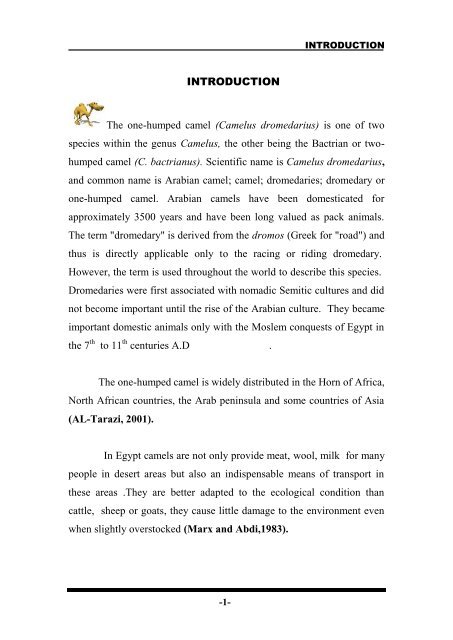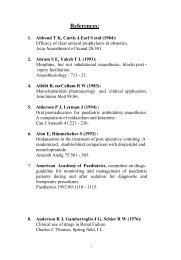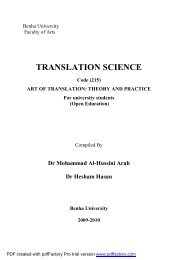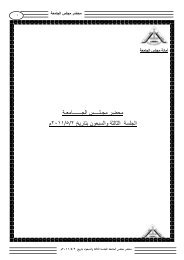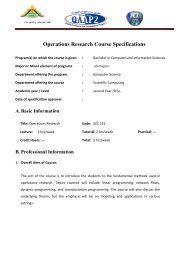INTRODUCTION The one-humped camel (Camelus dromedarius) is ...
INTRODUCTION The one-humped camel (Camelus dromedarius) is ...
INTRODUCTION The one-humped camel (Camelus dromedarius) is ...
You also want an ePaper? Increase the reach of your titles
YUMPU automatically turns print PDFs into web optimized ePapers that Google loves.
<strong>INTRODUCTION</strong><br />
<strong>INTRODUCTION</strong><br />
<strong>The</strong> <strong>one</strong>-<strong>humped</strong> <strong>camel</strong> (<strong>Camelus</strong> <strong>dromedarius</strong>) <strong>is</strong> <strong>one</strong> of two<br />
species within the genus <strong>Camelus</strong>, the other being the Bactrian or two<strong>humped</strong><br />
<strong>camel</strong> (C. bactrianus). Scientific name <strong>is</strong> <strong>Camelus</strong> <strong>dromedarius</strong>,<br />
and common name <strong>is</strong> Arabian <strong>camel</strong>; <strong>camel</strong>; dromedaries; dromedary or<br />
<strong>one</strong>-<strong>humped</strong> <strong>camel</strong>. Arabian <strong>camel</strong>s have been domesticated for<br />
approximately 3500 years and have been long valued as pack animals.<br />
<strong>The</strong> term "dromedary" <strong>is</strong> derived from the dromos (Greek for "road") and<br />
thus <strong>is</strong> directly applicable only to the racing or riding dromedary.<br />
However, the term <strong>is</strong> used throughout the world to describe th<strong>is</strong> species.<br />
Dromedaries were first associated with nomadic Semitic cultures and did<br />
not become important until the r<strong>is</strong>e of the Arabian culture. <strong>The</strong>y became<br />
important domestic animals only with the Moslem conquests of Egypt in<br />
the 7 th to 11 th centuries A.D .<br />
<strong>The</strong> <strong>one</strong>-<strong>humped</strong> <strong>camel</strong> <strong>is</strong> widely d<strong>is</strong>tributed in the Horn of Africa,<br />
North African countries, the Arab peninsula and some countries of Asia<br />
(AL-Tarazi, 2001).<br />
In Egypt <strong>camel</strong>s are not only provide meat, wool, milk for many<br />
people in desert areas but also an ind<strong>is</strong>pensable means of transport in<br />
these areas .<strong>The</strong>y are better adapted to the ecological condition than<br />
cattle, sheep or goats, they cause little damage to the environment even<br />
when slightly overstocked (Marx and Abdi,1983).<br />
-1-
……….…………………..……………………………….…... Introduction<br />
Camel’s meat <strong>is</strong> considered as <strong>one</strong> of the important animal protein<br />
in Egypt so to face the increased requirement of meat, large numbers of<br />
<strong>camel</strong>s are imported every year from the Sudan for slaughtering in Egypt.<br />
Lung infections, especially pneumonia, are major d<strong>is</strong>eases of<br />
domestic animals. Outbreaks occur in <strong>camel</strong>, cattle, buffaloes and small<br />
ruminants in various countries (Costa et al. 1998, Schwartz et al. 1992,<br />
Selman et al. 1983). Only few studies were found in the available<br />
literature on pathological and bacteriological affections of pneumonic<br />
lungs in <strong>camel</strong>s. Most of the studies on <strong>camel</strong>s were about parasitic<br />
infections (AL-Rawashdeh et al. 1999, Blood et al. 1990, Musa et al.<br />
1989).<br />
On the second ax<strong>is</strong>, hepatic affections of bacterial origin were<br />
common in animals and hepatit<strong>is</strong> was the major type of affections (Jubb<br />
et al. 1993). However, the relation between lung and liver lesions were<br />
did not previously studied in <strong>camel</strong>s. <strong>The</strong>refore, we concluded the aim of<br />
th<strong>is</strong> work to study the etiology (bacterial causes ) and h<strong>is</strong>topathological<br />
findings of lung lesions in native and imported <strong>camel</strong>s slaughtered in<br />
Egyptian abattoirs as well as to study the hepatic lesions associated with<br />
progressive lung lesions in the same <strong>camel</strong> in order to understanding the<br />
development of Hepatopulmonary syndrome.<br />
-2-


